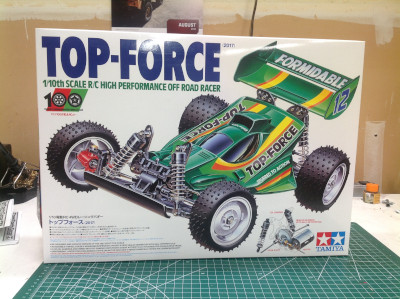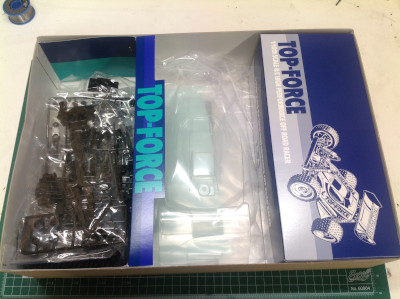Tamiya Top Force Project
Page 1: Assembly
The Top Force uses the DF-01 chassis which was previously used on
the Manta Ray and the builds are extremely similar. See my Manta Ray page for additional photos and build details.
The Top Force box really doesn't do justice to the glorious model
within, but the cover art is pretty nice. Inside are dividers but
no blister packs.
There are a substantial number of parts involved in building the Top
Force as you can see. Apart from the numerous plastic sprues,
there are also 6 bags of hardware. The obvious difference between
this pile of parts and those of the previous DF-01, the Manta Ray, is
the use of FRP chassis plates instead of a plastic bathtub.
The build begins with the front and rear differentials. While the
Manta Ray used gear differentials, the Top Force uses ball differentials
in both front and rear gearboxes. The left hand picture shows the
balls which are housed in the main spur gear. The balls in the right
hand photo are part of a thrust bearing which prevents the clamping bolt
from unthreading when the diff is slipping.
The completed rear differential can now be placed into the gearbox
housing. It inserts from the rear which allows it to be serviced
without removing the gearbox from the chassis.
The motor mount is a determinant assembly which uses sets of fixed holes
to set the gear mesh, allowing a pinion anywhere from 16 to 21
teeth. I'm using the largest pinion which should yield the highest
top speed. The motor mount then bolts into the rear gearbox ahead
of the rear axle.
The rest of the gearbox is just like the Manta Ray, except that one of
the aluminum gears has been replaced with nylon. This supposedly
solves a notorious wear problem of the original. The bevel gears
drive the prop shaft which will go to the front gearbox.
Here we can see some more differences from the Manta Ray in the rear
suspension. The plastic shock tower has been replaced with FRP and
the fixed length upper links have been replaced with adjustable rods
(but not turnbuckles).
The lower arms and uprights are identical to the Manta Ray.
The front gearbox appears to be just like the Manta Ray. The only
internal difference (not visible externally) is the use of a ball
differential.
Like the changes to the rear gearbox, we've added an FRP shock tower and
adjustable upper links to the front suspension. Lower arms,
C-hubs, and knuckles are from the Manta Ray.
The dual bellcrank steering is very similar in layout to the Manta Ray,
but the simple z-bent center rod has been replaced with an adjustable
link with ball ends. The FRP chassis plate is a complete departure
from the Manta Ray's plastic bathtub, but the servo and battery
positions have not changed.
The shocks are the same plastic CVAs as the Manta Ray, but molded in
black instead of yellow. Once built and filled, they can be
installed on the front and rear suspension modules which can then be
bolted to the chassis plate with the wire prop shaft between them.
An upper FRP chassis plate completes the chassis build. Now we
just need to add the electronics. I used a Hobbywing ESC because I
knew I wanted to use a motor much hotter than the stock silver
can. Because the battery does not need to sit in a molded curved
battery tray, you can fit a modern Li-Po battery. The tires use
rectangular spikes.
I knew that the standard motor was going to be inadequate for this model
so I checked into what optional motors might have been available at the
time it was originally released. The Dynatech 01R seemed to be
the best match. This is a 19 turn motor as opposed to the 27 turn
stock motor which makes it much faster (and smoother too). Highly
recommended, though I'm sure a modern Super Stock BZ motor would do just
as well.
The body attaches with a single body clip at the front and back along
with a long strip of Velcro along either side. The rear wing is
quite fragile because the sides are only a single layer thick.
This makes it a lot easier to paint compared with the narrow vertical
pockets in most wings, but also thin. Sure looks good though.
Here is a comparison with the rare and top-of-the-line Top Force Evolution.
©2019 Eric Albrecht

